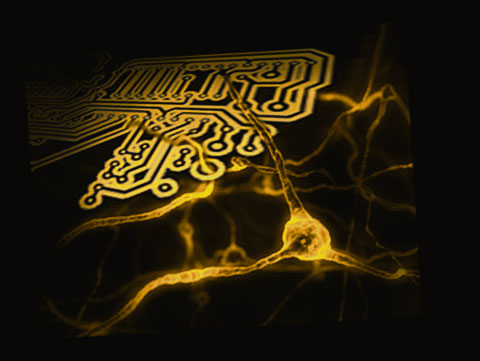For his PhD research, Dr Christos Strydis rethought the architecture for processors in biomedical implants.
Saying that they are committed to their research into neurostimulation is an understatement.
In their quest to develop a treatment for patients with tinnitus, a syndrome where people hear phantom noises, Professor Dirk de Ridder, a neurosurgeon at Antwerp University Hospital, and Professor Eddy van der Velden, a neuroscientist at Antwerp’s Eeuwfeestkliniek surgical hospital, are about to be operated on themselves. During an experiment to be held at the end of this month, the professors will have wires sticking out of the back of their heads, through which electrical pulses will travel to their brains.
“They are really crazy,” says computer engineer, Dr Christos Strydis, laughing. In his office, Dr Strydis shows an application on his smart phone. With this app he will command the device – which is the size of a packet of cigarettes – that is attached to the guinea pig professors and generates the pulses. Depending on the frequency of the pulses, the test subjects might feel energetic, euphoric or sleepy, to name but a few of the possible states.
Strydis is part of a large team of researchers from the faculties of Electrical Engineering, Mathematics and Computer Science, and Applied Sciences, who over the years have been working with the Belgian medics on biomedical implants. The team’s goal is to develop tiny, low-energy consuming implants that can be controlled by software, rather than being based solely on hardwired circuits.
Strydis has been focusing on the type of processor needed for such devices. Last month he defended his PhD thesis, titled ‘Universal processor architecture for biomedical implants.’
Strydis believes that it’s time for a paradigm shift in the field of biomedical implants: “One big problem is that the electrical signals created by implants no longer aid patients with neurological diseases after a certain period of time, because the body simply gets used to the signals and ignores them. So the device should be smarter and more flexible. You should be able to programme it. What’s more, every patient is different, so standard implants with standard signals do not work optimally for everyone.”
It will take at least another five years before the device built by the Delft researchers will be miniaturised enough to be placed directly under the skull of patients, Strydis surmises. Neuroscientist Prof. van der Velden hopes that the battery inside the implant, which ultimately must work at a voltage of no more than half a millivolt, will be recharged by the brain.
“Als studentenraad zijn wij voor het behoud van de onderwijskwaliteit. Die moet worden bewaakt. Wij krijgen signalen dat de onderwijskwaliteit steeds meer onder druk komt te staan, doordat voor de stijgende aantallen studenten niet meer docenten en faciliteiten komen. Ontbreekt het je aan financiële middelen om dat aan te pakken, dan is de numerus fixus het laatste redmiddel.
Het is jammer, maar er is niks anders meer mogelijk. We redden het niet meer met efficiencyslagen. Numerus fixus is het enige wettelijke middel dat rest. Maar het is zeker niet het ultieme instrument, want ik betwijfel of eindexamencijfers een goede indicatie geven van toekomstig studiesucces. Wat dat betreft had de universiteit beter op een eerder moment een aanvraag kunnen indienen, dan was er wellicht tijd geweest om vanaf het begin ook andere criteria te laten meewegen.”


Saying that they are committed to their research into neurostimulation is an understatement. In their quest to develop a treatment for patients with tinnitus, a syndrome where people hear phantom noises, Professor Dirk De Ridder, a neurosurgeon and neuroscientist at University Hospital Antwerp, and assistant professor Eddy van der Velden, a medical researcher at Antwerp’s Monica hospital, are about to be operated on themselves. During an experiment to be held at the end of this month, the professors will have wires sticking out of the back of their heads, through which electrical pulses will travel to their brains.
“They are really crazy,” says computer engineer, Dr Christos Strydis, laughing. In his office, Dr Strydis shows an application on his smart phone. With this app he will command the device – which is the size of a packet of cigarettes – that is attached to the guinea pig professors and generates the pulses. Depending on the frequency of the pulses, the test subjects might feel energetic, euphoric or sleepy, to name but a few of the possible states.
Strydis is part of a large team of researchers from the faculties of Electrical Engineering, Mathematics and Computer Science, and Applied Sciences, who over the years have been working with the Belgian medics on biomedical implants. The team’s goal is to develop tiny, low-energy consuming implants that can be controlled by software, rather than being based solely on hardwired circuits.
Strydis has been focusing on the type of processor needed for such devices. Last month he defended his PhD thesis, titled ‘Universal processor architecture for biomedical implants.’
Strydis believes that it’s time for a paradigm shift in the field of biomedical implants: “One big problem is that the electrical signals created by implants no longer aid patients with neurological diseases after a certain period of time, because the body simply gets used to the signals and ignores them. So the device should be smarter and more flexible. You should be able to programme it. What’s more, every patient is different, so standard implants with standard signals do not work optimally for everyone.”
It will take at least another five years before the device built by the Delft researchers will be miniaturised enough to be placed directly under the skull of patients, Strydis surmises. Neuroscientist Prof. van der Velden hopes that the battery inside the implant, which ultimately must work at a voltage of no more than half a millivolt, will be recharged by the brain.


Comments are closed.